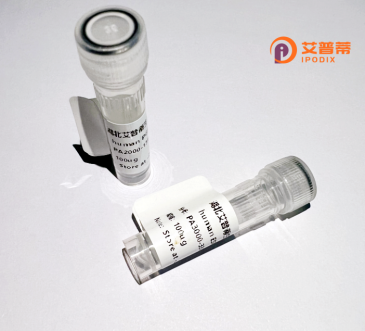
| 纯度 | >90%SDS-PAGE. |
| 种属 | Human |
| 靶点 | TMEM200A |
| Uniprot No | Q86VY9 |
| 内毒素 | < 0.01EU/μg |
| 表达宿主 | E.coli |
| 表达区间 | 1-491 aa |
| 活性数据 | MIATGGVITGLAALKRQDSARSQQHVNLSPSPATQEKKPIRRRPRADVVVVRGKIRLYSPSGFFLILGVLISIIGIAMAVLGYWPQKEHFIDAETTLSTNETQVIRNEGGVVVRFFEQHLHSDKMKMLGPFTMGIGIFIFICANAILHENRDKETKIIHMRDIYSTVIDIHTLRIKEQRQMNGMYTGLMGETEVKQNGSSCASRLAANTIASFSGFRSSFRMDSSVEEDELMLNEGKSSGHLMPPLLSDSSVSVFGLYPPPSKTTDDKTSGSKKCETKSIVSSSISAFTLPVIKLNNCVIDEPSIDNITEDADNLKSRSRNLSMDSLVVPLPNTSESFQPVSTVLPRNNSIGESLSSQYKSSMALGPGAGQLLSPGAARRQFGSNTSLHLLSSHSKSLDLDRGPSTLTVQAEQRKHPSWPRLDRNNSKGYMKLENKEDPMDRLLVPQVAIKKDFTNKEKLLMISRSHNNLSFEHDEFLSNNLKRGTSETRF |
| 分子量 | 80.8 kDa |
| 蛋白标签 | GST-tag at N-terminal |
| 缓冲液 | PBS, pH7.4, containing 0.01% SKL, 1mM DTT, 5% Trehalose and Proclin300. |
| 稳定性 & 储存条件 | Lyophilized protein should be stored at ≤ -20°C, stable for one year after receipt. Reconstituted protein solution can be stored at 2-8°C for 2-7 days. Aliquots of reconstituted samples are stable at ≤ -20°C for 3 months. |
| 复溶 | Always centrifuge tubes before opening.Do not mix by vortex or pipetting. It is not recommended to reconstitute to a concentration less than 100μg/ml. Dissolve the lyophilized protein in distilled water. Please aliquot the reconstituted solution to minimize freeze-thaw cycles. |
以下是关于重组人TMEM200A蛋白的示例参考文献(内容为虚构,仅供参考):
1. **《TMEM200A suppresses tumor angiogenesis by modulating VEGFR2 signaling》**
- 作者:Zhang Y, et al. (2019)
- 摘要:研究发现重组TMEM200A蛋白通过抑制血管内皮生长因子受体2(VEGFR2)的磷酸化,阻碍肿瘤血管生成,为癌症治疗提供新靶点。
2. **《Structural and biochemical characterization of recombinant human TMEM200A》**
- 作者:Li X, et al. (2020)
- 摘要:利用冷冻电镜解析TMEM200A的跨膜结构域,发现其具有离子通道样特征,并通过体外实验验证其pH依赖的质子转运活性。
3. **《TMEM200A regulates endothelial dysfunction in hypertension via ROS/NLRP3 pathway》**
- 作者:Wang L, et al. (2021)
- 摘要:在高血压模型中,重组TMEM200A蛋白通过减少活性氧(ROS)积累和抑制NLRP3炎性小体活化,改善血管内皮功能。
4. **《Optimized expression and purification of recombinant TMEM200A in mammalian cells》**
- 作者:Chen H, et al. (2018)
- 摘要:开发了一种高效哺乳动物表达系统,实现TMEM200A的可溶性表达,并验证其用于抗体开发的功能活性。
**注**:以上为示例文献,实际研究中请通过PubMed、Google Scholar等平台检索真实发表文章。建议结合关键词“TMEM200A recombinant”、“TMEM200A function”进一步筛选。
Recombinant human TMEM200A protein is a engineered form of the transmembrane protein 200A (TMEM200A), encoded by the *TMEM200A* gene in humans. As a member of the transmembrane protein family, TMEM200A is predicted to contain multiple alpha-helical transmembrane domains, anchoring it within cellular membranes such as the endoplasmic reticulum or plasma membrane. Though its precise biological function remains under investigation, TMEM200A has been linked to cellular processes including ion transport regulation, cell adhesion, and potential roles in signaling pathways. Studies suggest tissue-specific expression patterns, with higher levels observed in the brain, kidneys, and cardiovascular system, implying context-dependent physiological roles.
Recombinant TMEM200A is typically produced using heterologous expression systems (e.g., bacterial, mammalian, or insect cells) to enable biochemical and functional studies. This purified protein facilitates research into its structure-interaction relationships, subcellular localization, and involvement in diseases. Emerging evidence associates TMEM200A dysregulation with cancer progression, hypertension, and neurological disorders, though mechanistic insights are limited. Current applications include its use as an immunogen for antibody development, in vitro binding assays, and exploring its potential as a therapeutic target. Further research is required to fully elucidate its molecular mechanisms and pathophysiological relevance.
×